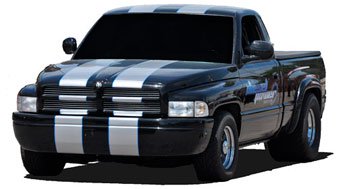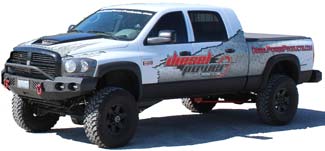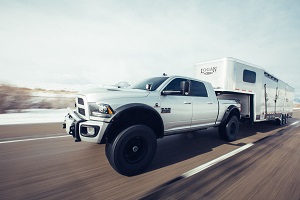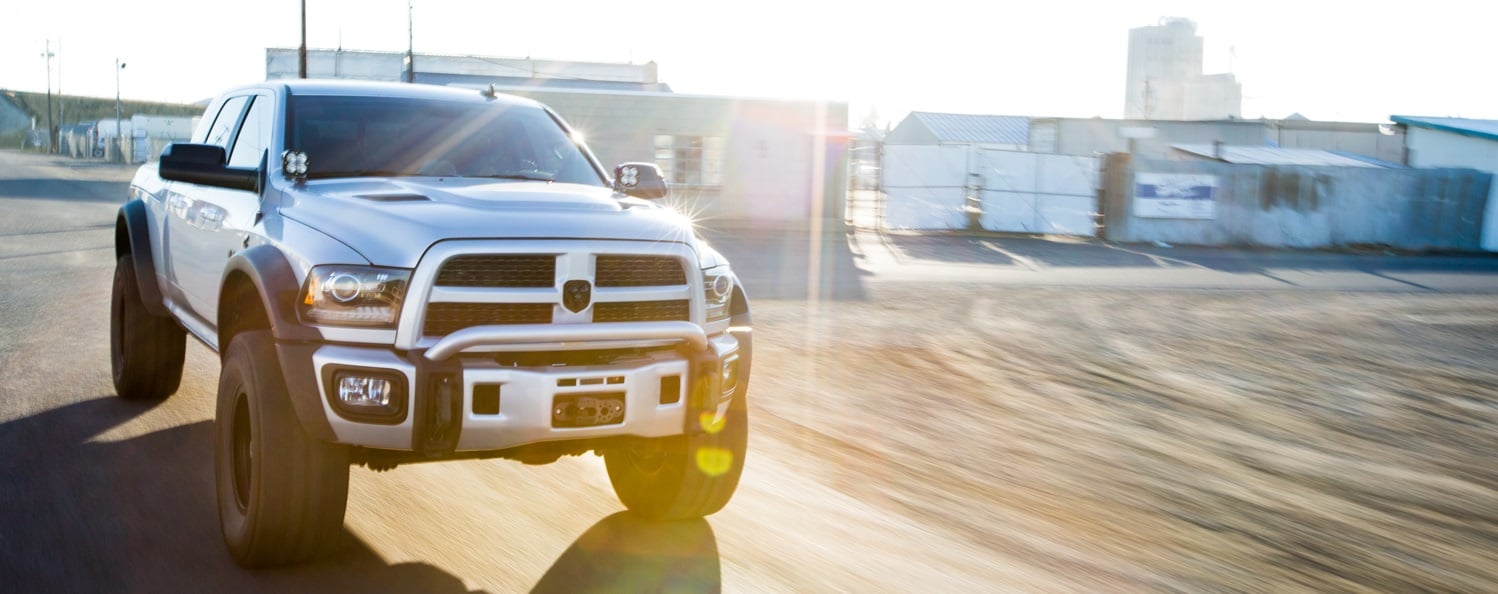Written By: L.T. Tolman
We’re going to be taking a closer look at some of the most popular diesel trucks pumped out over the last 25 or so years, and of course the Dodge Ram is a popular choice. Powered by Cummins since 1989, they have gone through several iterations, with 2019 ushering in the fifth generation of Ram. If you want to daily drive one of these classic American pickups, that’s certainly doable, even with the earliest models. We’ll help you identify some common problems and solutions of each body style, and ways to set your Ram apart from the herd. Of course, the Ram was available in 1/2 ton models, but our discussion will be limited to 3/4 and 1-ton trucks powered by the Cummins diesel. And that combination started back in 1989.
1st Gen, 1981 to 1993
This body style was introduced in 1981, and the legendary Cummins was introduced in 1989. Today, these old “squarebody” Dodges are getting very hard to find in decent shape with very little rust, and since they are as simple to work on as they are durable, most owners don’t want to get rid of them. Very few creature comforts were available by today’s standards, but they were built as solid as a brick. You can expect normal wear and tear from a truck this old, but usually very little goes wrong.
Many of the automatic transmissions found behind the Cummins engine have been unable to cope with the torque being fed into them, and the first gen is a prime example. The A618 four speed automatic was “rated” to handle 450 pounds of torque, just 50 more than the VE Cummins produced. Even the most basic fueling mods can send you over the theoretical rating, but in the real world, even bone stock engines can overpower the A618. If you want to keep that old First Gen on the road, likely you’ll be making an investment in a transmission at some point. Rather than just replace it with a stock trans that will fail again, it’s a good idea to step up to an upgraded transmission like the ATS Stage 2. It’s been modified internally with additional clutches and a reworked valvebody to better hold more torque, and it comes with a billet converter and extra deep pan for more fluid capacity.

2nd Gen, 1994 to 2002
While the P-pump Cummins in the 2nd gen truck are rock solid, the rest of the truck wasn’t as overbuilt, so if you own one, there are a few things you need to keep in mind. Just like the A618 before it, the 47RH or 47RE automatic transmission really isn’t up to the task of handling the torque output of the Cummins, so if you have a modified engine and a stock transmission, be prepared for a rebuild. Luckily there are many upgrades available to help the autos hold more power, like additional clutches, stronger bands, modified valvebodies, and multi-disc torque converters. Many owners prefer the simplicity and strength of a manual gearbox, and depending on the year, the 2nd gens were equipped with either a 5-speed NV4500 or the later 6-speed NV5600. The only major thing to worry about on either version is the clutch making the connection between engine and transmission. Torque from the engine can easily overcome the holding power of the stock single disc clutch, leading to slip under load. But there’s an easy fix; simply install a stronger South Bend dual-disc clutch assembly. With two friction discs that are a larger diameter than stock combined with a stronger pressure plate, its holding power goes up tremendously, while still retaining easy pedal effort and smooth engagement, making for easy trailer towing and daily driving.
The chassis of the 2nd gen 4wd trucks have a few shortcomings with the steering and suspension that are exaggerated on higher mileage or lifted trucks. Once parts like control arm bushings, track bar ends and steering boxes are worn, the truck will wander down the road, making it hard to keep the truck centered in the lane, and in just right conditions death wobble can occur, which consists of violent and uncontrollable shaking of the front wheels. While you can rebuild the front end with original parts, the design is inherently flawed, and could use an upgrade in many areas.
Ideally, you could start off with a new stronger steering gearbox from Red-Head which has been modified to accept oversize bearings and internal parts, for tighter handling and more durability than a stock remanufactured steering gear. To add some additional reinforcement, install a BD Diesel Steering Box Stabilizer which braces the output shaft of the steering box, which fights death wobble, and helps the steering box last longer. Finally, the track bar, tie rod, and drag link should all be updated to a 2008 and newer design where the tie rod goes from wheel to wheel, rather than the Y-type steering found on the earlier trucks. Synergy Manufacturing makes reinforced steering linkage for the front end of your 2nd gen, which when combined with a better box and stabilizer will totally transform the steering and road feel, and virtually eliminate the potential for death wobble.
Finally, you can’t discuss the 2nd gen Ram without talking about the dashboard. The plastic material Dodge selected to make their dash doesn’t hold up well to years of UV exposure from the sun, and 9 out of 10 dashboards will be cracked, and some neglected trucks will have basketball sized chunks just missing. While you can sweep the problem under the rug by covering it with a cheap carpet, replacement dash tops are now available from Accutrim, which are made from a material that’s better suited for exposure to the sun. You can remove and totally replace the factory dashboard, giving your 2nd gens interior a fresh new look.
At the end of the day, a 2nd gen Ram is anywhere between 17 and 25 years old and most of them have well over 200,000 miles, but they are a timeless body style which still looks great to this day, so it’s no wonder they still sell for a premium. If you want to daily drive one, just understand it’s a bit of a commitment. Just be prepared to spend a little money on it every now and then, and you can keep that classic American iron driving down the road for years to come.

3rd Gen, 2003 to 2009
There were several big changes during the 3rd gen body style, ranging from the addition of common rail injection, the switch from 5.9 to 6.7-liter engines, new emissions control systems, and several different transmissions. The 5.9’s came equipped with the 48RE four speed automatic, and the later 6.7-liter trucks came with a new six speed automatic, the 68RFE. While some have speculated RFE stands for “really freakin’ excellent”, others have found it has serious shortcomings. The two additional forward gears help keep the engine closer to its peak torque, but the new clutch to clutch style transmission needs a little help holding up to extra power of the 6.7. For mild builds, an ATS Performance valve body and Co-pilot Transmission Controller make a huge difference, helping the 68RFE hold another 200 horsepower over stock. The valve body modifies the hydraulic circuits that control the clutch packs, and the co-pilot takes over transmission control, so shift points are improved, line pressure is increased, torque converter clutch application is optimized, and your overall driving experience is improved. In short you can bump the 68RFE’s torque capacity without getting into a full overhaul of the transmission.

4th Gen, 2010 to 2018
The 4th gen is considered by many to be the best looking and performing Ram to date. Three different transmissions were available; the 68RFE automatic, the G56 6-speed manual, and the new Aisin Seki AS69RC 6-speed automatic found behind the 6.7 High Output. While it’s the strongest rated transmission out of the three, its less than ideal from a high-performance standpoint since there is limited aftermarket support and there is currently no TCM tuning available to alter shift RPM, line pressure, or torque management. Other notable design changes in the 4th gen include a switch to a radius arm front suspension which was a huge improvement over previous style 4 links. Out back, on the 2014 Ram 2500’s, a rear 4-link coil sprung rear axle was released, an industry first for a HD truck.
Because of the redesigned front styling, the factory intercooler now sits below the radiator and behind the front bumper and is quite small compared to earlier generations. When increasing performance, the turbocharging system makes extra heat, which the stock intercooler has a hard time coping with. A Banks Techni-Cooler will fit into the same place as the stock cooler but is much larger and will extract more heat from the compressed air. The core design is also more efficient so it will flow more CFM, leading to improvements in power, a reduction in spool-up time, and of course better fuel economy.
When making a decision on which generation of Ram to purchase, there are a lot of factors to consider. The later models will have a much nicer and more comfortable interior with more bells and whistles, and the older it is, the more upkeep you will have. Just remember the two biggest issues Dodge is known for is weak automatic transmissions and poorly designed front suspension. There are fixes for each of these problems, making the Ram a popular truck to modify. Whether you want a drag truck, tow rig, or just an all-around daily driver, there is a Ram out there with your name on it.


what is your favorite type of dodge
Logan, that’s a very open ended question! That really depends on budget, uses, and preferences. I went through this question a couple of years ago when I decided again it was time for a different truck and I deliberated on what, at that time, I wanted out of a truck. At that time, I’d already had two Cummins and been around them the most, so opted to go back for another Cummins. Then, I filtered down what I was really using the truck for, budget, etc. and I landed on a 2003 through early 2004 Cummins quad cab, long bed, automatic transmission. And honestly, I’m still happy with that decision. My rationale on it was:
1.) I needed a four door because the kids aren’t getting any shorter
2.) I needed a long box because I do haul everything from quads and dirt bikes to rock and sand on a pretty frequent basis in the bed
3.) I went with the 2003-2004 because of the fact that basically its just modern enough with a common rail injection fuel system, but old school enough that its relatively simple to work on and parts and upgrades aren’t terribly expensive, plus no emissions devices on it that require maintenance
4.) I did go back and forth on automatic versus manual and decided to go with automatic because I knew I’d be putting a snow plow on it, and while its doable to plow in a manual, honestly, its just a lot easier to do it with an auto, and you can build an auto for any power level
Now, do I like other model year ranges of Cummins? Absolutely! First Gens are cool because they’re simply a classic body style with a bulletproof engine, but their auto is terrible and they ride like a chuck wagon unless you get creative. I do really like 2nd Gens, both 12 valve and 24 valve, but again, needed the bigger cab. Then, you get into the 6.7L’s with a vastly superior transmission and that run great, but I personally wanted as simplistic I could get while having a bigger cab, and not at the time and expense of an engine swap into something with a larger cab. And again, that’s just me. The 4th and 5th Gens (2010+ model years) have great power and a ton of features that make them a really reliable, comfortable truck with gobs of power. I think I could find a place for every single model of Ram, just depends on wants and budget at the end of the day.